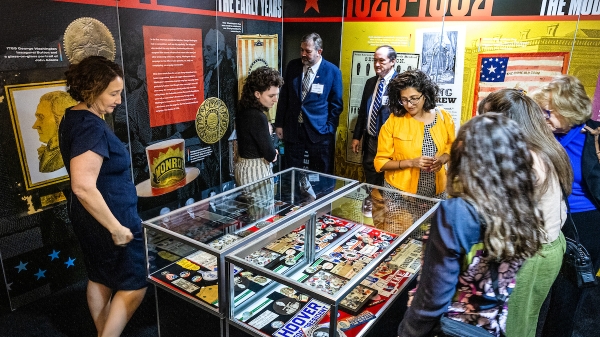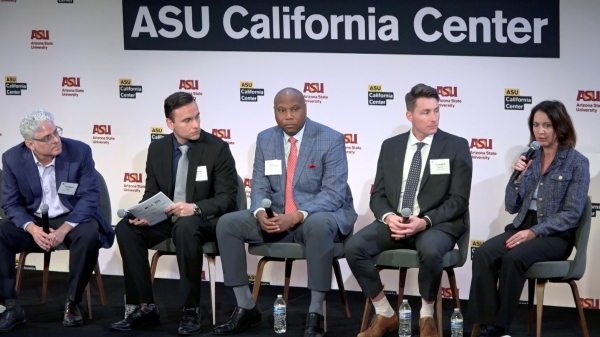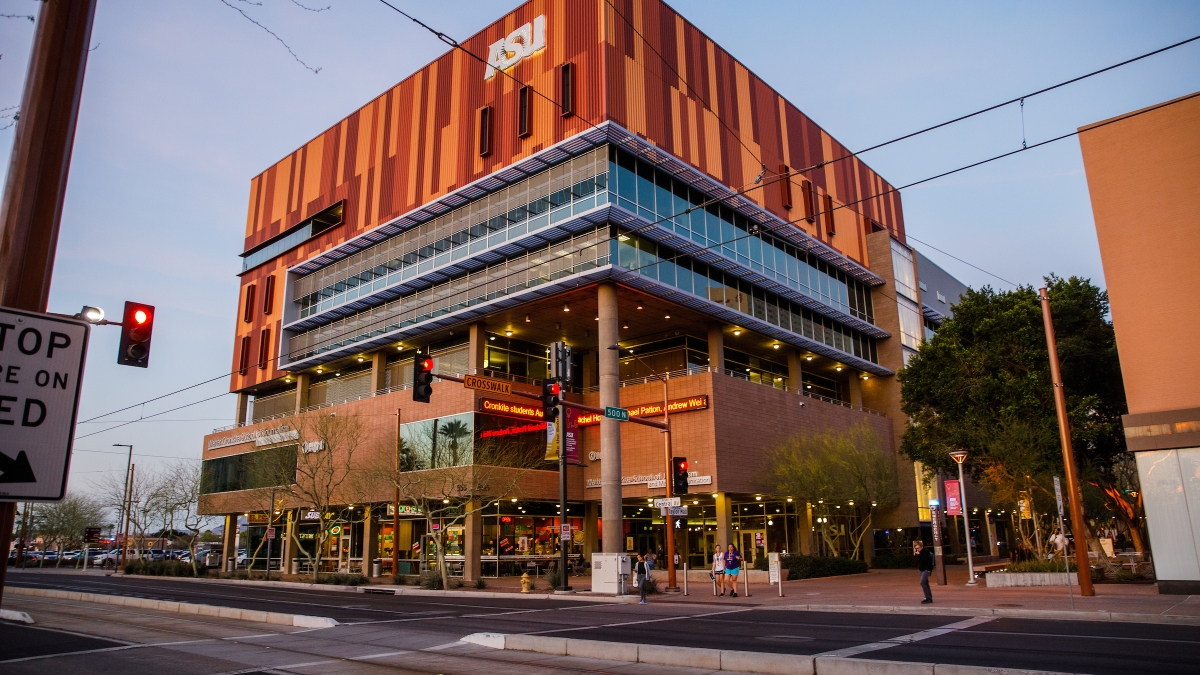The word came at 4:28 p.m. on a Wednesday in the middle of spring break: All classes at Arizona State University would be taught remotely in response to the outbreak of the coronavirus.
Eighty minutes later, faculty members at the Walter Cronkite School of Journalism and Mass Communication, many of whom had never taught online before, were signed up for a series of training sessions that would launch them into a strange new world.
Over the next three days, 124 faculty members teaching 193 in-person classes participated in a series of virtual sessions to learn not just the tools and technologies they would need to master by Monday morning, but to talk through how they would adapt their teaching methods for virtual classrooms.
They spent the weekend perusing an instructors’ site, developed on the fly by Assistant Dean Rebecca Blatt and jam-packed with resources and suggestions, and they reassured their students that not only would instruction continue, this would be a chance to create and innovate. Together, they would do what the best journalists and communication professionals have always done: Face the challenge and get the work done.
At 7:30 a.m. on Monday morning, March 16, the first students signed into their classes via Zoom. A team led by Assistant Dean Jessica Pucci and IT staff were standing by in a makeshift fourth-floor command center, monitoring classes on a half-dozen screens and stepping in to offer technical help and guidance in real time.
And so began the Cronkite School’s rapid-fire response to an unprecedented challenge facing universities across the country: how to keep students safe during a pandemic while delivering a quality education.
The Cronkite School has built a national reputation for delivering hands-on instruction through its “teaching hospital” model of education. The school offers 15 different professional programs that place students in newsrooms and labs to create news content and provide services to the university and the community. Students cover news from bureaus in Phoenix, L.A. and Washington, D.C., and produce a nightly newscast that reaches more than a million households on the main Arizona PBS channel. They create public relations campaigns and digital audience strategies for clients, produce national investigations and test new technologies.
Similarly, Cronkite classes are focused on teaching professional skills in addition to principles and values. Students learn a range of digital tools and technologies, from video editing to web design. Their instructors send them out daily to shoot video and photos, interview sources and go wherever news is happening, whether that’s the statehouse, an Indian reservation, an inner-city neighborhood or a sports arena.
In the wake of the outbreak of COVID-19, the school’s leadership called a halt to all field reporting. Students should continue reporting and producing and learning new technologies, said Dean Christopher Callahan, but they would have to do it from the safety of their homes.
The challenge to the faculty was clear: Transition not just the usual course material online but figure out how to deliver hands-on learning remotely.
Fernanda Santos, the former Phoenix bureau chief for The New York Times, now teaches narrative writing and bilingual journalism at the Cronkite School. She tells her students they have to go where the story is, which is to say where the people are.
“From Day One, I had been telling my narrative writing students that to be good narrative journalists, they had to get out of the office and spend time with their characters,” Santos said. “When the coronavirus pandemic forced us to move our classes online and kept students from doing any field reporting, I had to figure out ways to allow my students to continue reporting.”
On the first day of her new distance-learning class, Santos asked her students to brainstorm ideas. “One student, Brendon Derr, is writing about (female) video game developers and suggested playing video games with them online to get hints of their personality by observing how they react to other players,” she said. “Another, Megan Lupo, who's writing about the forgotten history of African Americans in Phoenix, talked about using Google Earth to see what stands in places that used to be occupied by cotton fields.”
Students in Cronkite News, the news division of Arizona PBS, launched a virtual newscast to replace the one they normally produce in state-of-the-art studios, and student reporters began churning out stories about the coronavirus impact in Arizona for readers of Cronkite News.
Students also continued to cover other stories, using whatever tools they had at their disposal. Senior Jordan Evans led the way with a weather forecast delivered from his Phoenix apartment, sharing his computer screen to show maps and charts. Meanwhile, MacKinley Lutes-Adloch and Jonmaesha Beltran managed to report on the state’s presidential primary from a distance, illustrated by a selfie from one of the voters they interviewed.
In the Cronkite News Sports Bureau, students who were no longer able to cover games went to work on a new project to recount the best moments in Arizona sports history and told stories of how the coronavirus is upending the world of sports. Senior Rob Werner anchored the first remote episode of Cronkite Sports Now from his bedroom in San Francisco.
In a schoolwide discussion board and via email and listservs, faculty began sharing a flood of ideas and resources. And in short order, students began reporting and conducting interviews using webcams, Facebook Live, Skype and Zoom. They recorded audio and shot video on their phones, wrote stories based on livestreams of Arizona House and Senate proceedings and attended virtual public safety conferences. They downloaded federal court documents, uploaded satellite images and scoured Google Earth.
Cronkite Assistant Professor Monica Chadha said students discovered there were many more ways of reporting and producing stories — even those that rely on images — than they had realized. For example, a group of students working on a project about national parks decided to combine a video of a Skype interview with stock footage from the National Parks Service — providing appropriate credit, she said. For another project, students plan to record Zoom interviews with students about how they’re adapting to remote classes and stitch them together for a compelling package.
To assist students without access to quality internet service or computers, the school mailed laptops and hot spots to their homes. And working with Adobe, the school extended access to the Adobe Creative Suite so students could edit audio, video and other files from their personal devices.
“I believe that students aren’t getting just an equivalent education, in some ways, it’s richer,” Callahan observed. “They are honing and growing skills like adaptability, creativity, teamwork and perseverance — characteristics that employers place a premium on and that define success in the fast-moving, 21st-century digital world.”
To quell concerns and communicate a hundred details about the shift to a virtual environment, Callahan began holding meetings every day via Zoom with groups of students, faculty and staff. He sent out nightly emails with updates on everything from how to access textbooks to which local restaurants are offering takeout and delivery options. After fielding questions from dozens of concerned parents, he set up a video conference specifically for them. More than 100 joined the first meeting although, Callahan quipped, “They weren’t nearly as proficient on Zoom as their children.”
He also commissioned new Assistant Dean Melanie Alvarez to find ways to keep students active and engaged socially. Sixty percent of the school’s 1,400 in-person students are from out-of-state, and many didn’t return from their spring break since they could continue their classes from anywhere. Others were cooped up in their dorm rooms on campus, and many were feeling disconnected and alone.
In less than 48 hours, Alvarez launched the “Cronkite Café,” a series of online social activities that includes daily informal meet-ups to share lunch, talk to faculty and chat with each other.
One group meets each week to talk about sports — and how much they miss them. In another, students discuss their favorite shows on streaming services like Netflix and Hulu and share recommendations.
After observing that a number of pets were showing up in Zoom classrooms, Alvarez created “Pets of Cronkite,” inviting students to show off their animals. One of the most popular offerings is a daily yoga class, taught by two certified yoga instructors in the school’s master’s degree program.
Instead of canceling regularly scheduled speakers, the school began livestreaming them so that students could watch from anywhere. And Associate Dean Mark Lodato developed a new Zoom series designed to give students career guidance and connect them with professionals. The first speaker was Chip Mahaney, lead recruiter at E.W. Scripps Co., the nation’s fourth-largest TV group.
Students also got in on the act, posting screen pictures of themselves in classes, taking goody bags to students holed up in the dorms (while maintaining social distancing) and hosting virtual dinners. There’s talk of starting a virtual magazine and planning a virtual fashion show.
“I love that my j-school created a whole calendar of social, recreational and professional development virtual events for students to stay connected during this strange time — kudos to Cronkite,” one student posted on Twitter.
Cronkite “is doing this right,” senior Mackenzie Shuman posted. It “should be an example to other journalism schools out there. Thank you for helping my final semester in college be a success!”
Elsewhere at Cronkite, faculty and staff are turning their attention to what the school can do to support professionals on the frontlines of serving the news and information needs of communities.
The Knight-Cronkite News Lab is collecting and sharing best practices for covering the fast-moving coronavirus story. A Corporation for Public Broadcasting leadership training program is being recast to help managers in public media lead their staffs during a time of crisis. And Arizona PBS, which is part of the Cronkite School, revised its entire daytime programming schedule to provide help to parents teaching their kids at home. The station also expanded its nightly public affairs show, “Horizon,” from half an hour to an hour to cover all things coronavirus and moved production to host Ted Simons’ home.
Callahan said a lot was accomplished in 10 days, but there’s more to be done. He and Janet Coats, the school’s director of innovation and strategy, are turning their attention to making sure that faculty and staff who are working from home feel supported. Coats is cuing up training and resources on everything from how to set up a home office to the importance of taking breaks. And the school’s development director, Liz Bernreuter, is leading an effort to set up a new fund to help students facing financial struggles resulting from the crisis.
Dominic Valente, a Cronkite graduate who teaches two sections of multimedia journalism, said he was completely stressed out by the prospect of switching to remote teaching in a matter of days on top of being basically confined to his house.
But, then, two days into the new regimen, his students showed up to class — along with their dogs — and delivered a rousing rendition of “Happy Birthday” to his fiancé.
“Because of the resilience my students and the leadership show, I know we’ll not only get through this, but we’ll excel,” Valente posted afterward on Twitter. “We got this!”
Top photo by FJ Gaylor.
Written by Kristin Gilger, senior associate dean for the Cronkite School. Janet Coats, executive director for innovation and strategy, contributed to this report.
More Law, journalism and politics

Exhibit uses rare memorabilia to illustrate evolution of US presidential campaigns
After one of the most contentious elections in history, a new museum exhibit offers a historical perspective on the centuries-old American process.“We The People! Electing the American President” had…

TechTainment conference explores the crossroads of law, technology, entertainment
What protections do writers, actors, producers and others have from AI? Will changing laws around name, image and likeness (NIL) eliminate less lucrative college sports programs?And what does…

How to watch an election
Every election night, adrenaline pumps through newsrooms across the country as journalists take the pulse of democracy. We gathered three veteran reporters — each of them faculty at the Walter…

